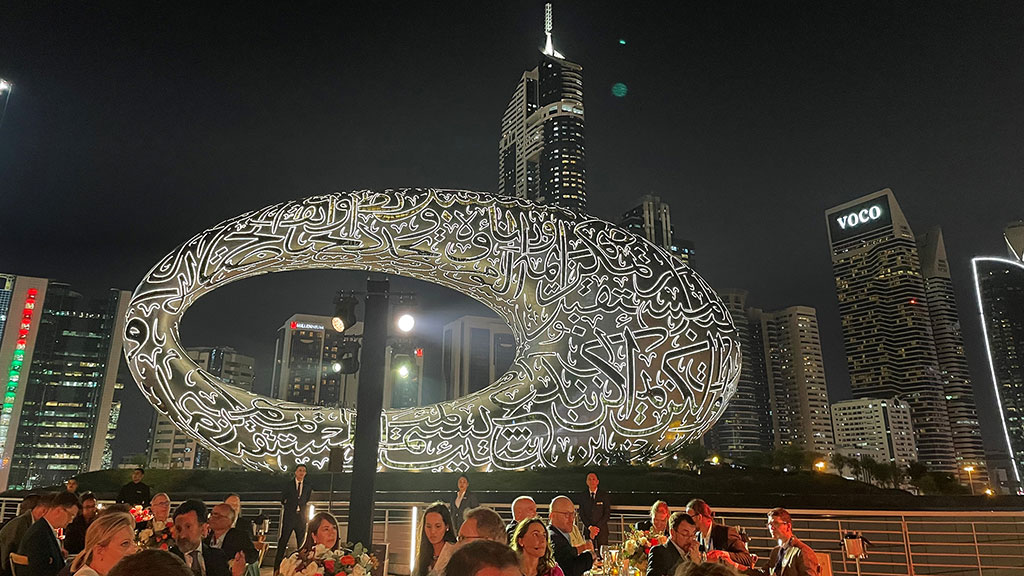COP28 Wrap Up: Bringing People Together for Global Collective Change
December 21, 2023 | By Juliette Morgan
Editor’s Note: Gensler attended COP28 in Dubai in early December 2023 to work with our partners toward sustainable solutions for the built environment. This post is the fourth in a series of daily recaps about our time at the event.
COP28 saw a record attendance of over 100,000 people — more than double the previous record of about 40,000 people at the 2021 talks in Glasgow, Scotland. With this kind of attendance, which included dozens of world leaders, one thing is clear: the world is leaning into the climate crisis, with more people than ever committing to, talking about, acting on, and collaborating for a better future. The fact that this year’s climate conference took place in the world’s foremost oil and gas regions was not lost on anyone, but it underscored for me the fact that we must be able to hold the contradiction of fossil fuel deals being made in a transition economy to investment in renewables. I was struck by the depth of the conversations which, compared to Greta Thunberg’s first protests in 2018, have shown a marked shift in commitment to understanding the scale of the problem, its complexity, and the response.
In the real estate and building sector, we saw the launch of Buildings Breakthrough on Built Environment Day, December 6. This was hard fought for, and the Governments of France and Morocco, together with the UN Environment Programme (UNEP), launched the initiative. This sees countries join forces to accelerate the transformation of the sector — accounting for 21% of global greenhouse gas emissions — with a view to making near-zero emissions and climate-resilient buildings the new normal by 2030. Twenty-seven countries so far have pledged their commitment.
The Breakthrough Agenda provides a framework for countries, businesses, and civil society to join together and strengthen their actions every year in key emitting sectors through a coalition of public-private global initiatives. This aims to strengthen international collaboration to decarbonise the building sector and make clean technologies and sustainable solutions the most affordable, accessible, and attractive option in all regions by 2030.
Celebrating Diversity With Voices From Every Corner
This year’s conference gave a voice to the voiceless and amplified the advocacy of women. Diversity was not only included but actively sought out. I saw humans from every corner of the Earth coming together to share knowledge, commitments, and purpose. I was powerfully reminded by both an Indian architect and a Kenyan building council member that global policies need to be globally applicable, taking into account both planned and unplanned cities.
What I saw was beautiful. It is said that birds and fish communicate fin-to-fin and wing-to-wing. The birds don’t individually see the whole shape of the murmuration, but they move as a flock. So too, do humans at COP. When that many people come together and move with intention to meet climate challenges and work with the planet, there’s a big energy, and we won’t yet know what that giant flock movement will do. We must trust in the process of emergence that will come from the one-to-one conversations and small-scale changes.
From Eritreans and Bhutanese rubbing shoulders with New York bankers, to local architecture students addressing construction leaders, to Ethiopian innovators recovering unrecyclable plastic, I don’t know any other meeting on Earth that has the capacity to bring such diversity together.
All this being said, Dubai is a challenging place to host a climate conversation. With 16-lane highways and glittering towers, it looks like the definition of what humans must reign in to stay below 1.5 degrees. The claim that the next 100 years of building work will be equal in scale to everything ever built to-date can make an environmentalist reel, given that the global carbon budget has eight years to run at the current rate of consumption. Architectural panels discussed how we must change what we aspire to. Masdar City’s Head of Design Management, Lutz Wilgen, implored that the role of the architect is to lead the client to seek humble architecture and planetary lightness. Understanding this context is critical.
Sustainable Design Is the New Non-Negotiable
We cannot stay complacent and design everything to net zero with no eye to global and national level carbon budgets — work that is being led by Exeter University. Nor can we afford to get carbon tunnel vision. Gensler’s recently unveiled 2024 Design Forecast lists sustainable design as non-negotiable as one of the “8 Trends Shaping Design in 2024,” and indeed this will be the case as we work towards a more sustainable future. During the week our co-CEO, Diane Hoskins, announced a new collaboration to promote IFC’s EDGE (“Excellence in Design for Greater Efficiencies”) Green Building certification program, and to train design leaders in our global offices to apply these standards in their projects.
We also assembled a COP28 panel to address design for a radically changing world, bringing developers, climate impact investors, advisors, and natural materials specialists together to discuss the future. Only by working at system scale and in collaboration will we get there, with a deep understanding that 70% of the decisions that affect the environment from a building are made in the first 10% of the design process, according to the UK Green Building Council (UKGBC).
Materiality is therefore key — from nature-based, recycled, or technocratic solutions, it has never been clearer that this is a time for pulling all of the levers. When using materials such as concrete in new builds in emerging cities, it is up to all of us to attempt to specify it, use it sparingly, deliver within budget, and shift demand to near or net zero. The World Green Building Council and the World Business Council for Sustainable Development are both working on alignment in global standards. It can’t come soon enough — 2023 has been the hottest year on record and Dubai’s 16-lane highways are still thronging with traffic, albeit some of it with electric vehicles (EVs), as COP concludes.
This year’s stock-take at COP revealed that Goal 11 of the UN’s Sustainable Development Goals (SDGs) — to make cities and human settlements inclusive, safe, resilient and sustainable — is not on track. Within the design community, the responsibility of future generations is to reduce emissions from our work by 45% in six years to create sustainable cities and communities. The world came together this week to acknowledge that designing the future will not look like the past. It’s clear that we are all committed to change, and we must now design like our lives depend on it, because they do.
For media inquiries, email .

